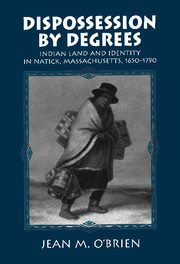Book contents
- Frontmatter
- Contents
- List of illustrations
- Acknowledgments
- Prologue: “My land”: Natick and the narrative of Indian extinction
- 1 Peoples, land, and social order
- 2 The sinews and the flesh: Natick comes together, 1650–75
- 3 “Friend Indians”: Negotiating colonial rules, 1676–1700
- 4 Divided in their desires, 1700–40
- 5 Interlude: the proprietary families
- 6 “They are so frequently shifting their place of residence”: Natick Indians, 1741–90
- Conclusion
- Index
4 - Divided in their desires, 1700–40
Published online by Cambridge University Press: 04 August 2010
- Frontmatter
- Contents
- List of illustrations
- Acknowledgments
- Prologue: “My land”: Natick and the narrative of Indian extinction
- 1 Peoples, land, and social order
- 2 The sinews and the flesh: Natick comes together, 1650–75
- 3 “Friend Indians”: Negotiating colonial rules, 1676–1700
- 4 Divided in their desires, 1700–40
- 5 Interlude: the proprietary families
- 6 “They are so frequently shifting their place of residence”: Natick Indians, 1741–90
- Conclusion
- Index
Summary
It is very sure, the best thing we can do for our Indians is to Anglicise them in all agreeable Instances; and in that of Language, as well as others. They can scarce retain their Language, without a Tincture of other Salvage Inclinations, which do but ill suit, either with the Honor, or with the design of Christianity. The Indians themselves are Divided in the Desires upon this matter. Though some of their aged men are tenacious enough of Indianisme (which is not at all to be wondered at) Others of them as earnestly wish that their people may be made English as fast as they can.
Cultures in dialogue
In his 1710 characterization of Praying Indians as “Divided in the[ir] Desires” over culture change, New England Company official Samuel Sewall captured an important dynamic of community life in early eighteenth-century Natick. Indians drew upon both Indian and English cultural practices in shaping their community, as they had from the beginning. Though Sewall emphasized language as a central point of contention, which it surely was, cultural debates involved a full range of social institutions in the community. But it was the outcome of cultural negotiations about land, in particular, which stemmed from the Indians’ divided desires, that both magnified crucial divisions within the Indian community, and created the fault lines that eventually eroded Indian autonomy by facilitating English landownership in Natick.
- Type
- Chapter
- Information
- Dispossession by DegreesIndian Land and Identity in Natick, Massachusetts, 1650–1790, pp. 91 - 125Publisher: Cambridge University PressPrint publication year: 1997



